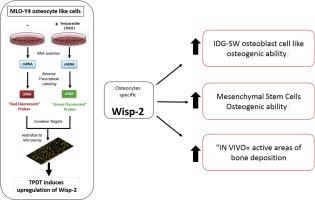Molecular and Cellular Endocrinology ( IF 3.8 ) Pub Date : 2020-05-18 , DOI: 10.1016/j.mce.2020.110817 Alberto Smargiassi 1 , Jessika Bertacchini 2 , Marta Checchi 2 , Francesco Potì 3 , Elena Tenedini 4 , Giuliana Montosi 5 , Maria Sara Magarò 2 , Emanuela Amore 2 , Francesco Cavani 2 , Marzia Ferretti 2 , Giulia Grisendi 6 , Delphine B Maurel 7 , Carla Palumbo 2

|
The Osteocyte, recognized as a major orchestrator of osteoblast and osteoclast activity, is the most important key player during bone remodeling processes. Imbalances occurring during bone remodeling, caused by hormone perturbations or by mechanical loading alterations, can induce bone pathologies such as osteoporosis. Recently, the active fraction of parathormone, PTH (1-34) or Teriparatide (TPTD), was chosen as election treatment for osteoporosis. The effect of such therapy is dependent on the temporal manner of administration. The molecular reasons why the type of administration regimen is so critical for the fate of bone remodeling are numerous and not yet well known. Our study attempts to analyze diverse signaling pathways directly activated in osteocytes upon TPTD treatment. By means of gene array analysis, we found many molecules upregulated or downregulated in osteocytes. Later, we paid attention to Wisp-2, a protein involved in the Wnt pathway, that is secreted by MLO-Y4 cells and increases upon TPTD treatment and that is able to positively influence the early phases of osteogenic differentiation. We also confirmed the pro osteogenic property of Wisp-2 during mesenchymal stem cell differentiation into the preliminary osteoblast phenotype. The same results were confirmed with an in vivo approach confirming a remarkable Wisp-2 expression in metaphyseal trabecular bone. These results highlighted the anabolic roles unrolled by osteocytes in controlling the action of neighboring cells, suggesting that the perturbation of certain signaling cascades, such as the Wnt pathway, is crucial for the positive regulation of bone formation.
中文翻译:

特立帕肽治疗诱导的WISP-2表达影响体外成骨细胞分化并改善体内成骨作用。
骨细胞被认为是成骨细胞和破骨细胞活动的主要协调器,是骨骼重塑过程中最重要的关键角色。荷尔蒙摄动或机械负荷变化引起的骨骼重塑过程中出现的失衡,可引起骨骼疾病,例如骨质疏松症。最近,副甲状腺激素的活性成分选择PTH(1-34)或Teriparatide(TPTD)作为骨质疏松症的选择治疗。这种疗法的效果取决于给药的时间方式。给药方案类型对于骨骼重塑的命运如此重要的分子原因是很多的,并且还不为人所知。我们的研究试图分析在TPTD治疗后直接在骨细胞中激活的多种信号通路。通过基因阵列分析,我们发现骨细胞中许多分子被上调或下调。后来,我们关注了Wisp-2,这是一种参与Wnt途径的蛋白质,它由MLO-Y4细胞分泌,并在TPTD处理后增加,并且能够积极影响成骨分化的早期阶段。我们还证实了在间充质干细胞分化为初步成骨细胞表型过程中Wisp-2的促成骨特性。相同的结果被证实体内方法证实了在干phy端小梁骨中显着的Wisp-2表达。这些结果强调了骨细胞在控制邻近细胞的作用中所发挥的合成代谢作用,表明某些信号级联的扰动,例如Wnt通路,对骨形成的正向调节至关重要。











































 京公网安备 11010802027423号
京公网安备 11010802027423号